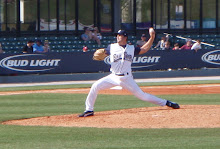
As if pitchers don't have enough to worry about when it comes to facing nine hitters trying to take their heads off. If one of those hitters happens to reach base, it is also the pitcher's responsibility to make sure the runner does not get too large of a lead or worse, steal a base. Many times, keeping a hitter on first or second base can make the difference between a runner grounding into a double play or possibly scoring on the same ground ball.
There are two main ways for a pitcher to keep the runner from getting too big of a jump when stealing or too large of a lead on the pitch. Both ways are based on preventing the pitcher from getting into a set routine. Unfortunately, pitchers are bred to repeat absolutely everything when it comes to their delivery. However, if the pitcher does the same thing when he comes set, the runner will be able to time his looks and holds and get the best possible jump. The first way to prevent this from happening is changing the number of "looks" after coming set out of the stretch position. In other words, changing the number of times a pitcher looks over at the runner to prevent the runner from getting a comfortable lead. Unless the runner is looking for you to pick off, he will be forced to stop lengthening his lead or even shorten the lead when the pitcher looks over. Plus, the change in looks forces the pitcher to change his timing before the pitch. This tactic leads us to the second form of holding the runner. In addition to changing looks, the pitcher must vary his holds before delivering the pitch. Sometimes, the pitcher will come set, look once, and then pitcher immediately. Other times, he could come set, look one, hold for a few extra ticks, look again, then pitch. Still other situations would have the pitcher coming set, not looking at all at the runner, and immediately deliver the pitch. You get the idea here. The key is to remain calm and under control. There's no reason to get over anxious, because as long as you hold the baseball, the runner cannot run without risking being picked off.
Another piece of the puzzle is the pitcher's ability to be quick to the plate. After varying looks and timing, the pitcher must shorten his leg lift and release the baseball in shorter amount of time. If you look at it like a math equation, we can deduce how fast a pitcher must be to prevent the runner from having a good chance to swipe the bag. If it takes the normal, above average runner just under 4 seconds to run 80 ft (the distance from a lead off to the next base), the combined time from the delivery to the catcher and catcher to second must be less than that. We know that the cut off mark for a decent catcher's arm from home to second is 2.0 seconds or less. Therefore, a pitcher must be able to start his delivery and get the ball to the catcher in less than 1.8 seconds (leaving a .2 second margin for error). Righties should work a little quicker than this, utilizing some variation of a shorter/quicker leg (known as the slide step) to get the ball to the plate in 1.5 seconds or less. Lefties have the luxury of looking at the runner as they left their leg and can afford to be a bit slower.
So this concludes part 1 of the "Controlling the Running Game" segment here on LIM. I will look at things that the pitcher and the other fielders can do to be on the same page with holds and pick offs to further prevent the runner from moving illegally (stealing the bag).
Until Next Time!!!

No comments:
Post a Comment